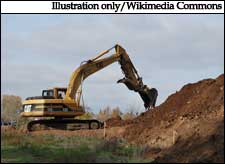 D.K. Vyas,
D.K. Vyas,
Chief Executive Officer,
Srei BNP Paribas
Srei BNP Paribas is amongst the largest NBFCs as well as the largest construction and mining equipment financiers in India. It is a 50:50 joint venture between Srei Infrastructure Finance Ltd and BNP Paribas Lease Group, the largest leasing group in Europe. D.K. Vyas, in an email interaction with Prashant C. Trikannad, discusses the impact of the slowdown on infrastructure equipment finance.
How do you rate the performance of the Indian infrastructure sector in the past two years?
There is nothing to rate here. The economy slowed down considerably during the last two years; quite naturally infrastructure growth has suffered too. 2013 has been an exceptionally bad year for the infrastructure sector. Although the PPP model has been the preferred mode of infrastructure creation in India, sustaining private sector interest has become more challenging now.
Can you talk about the critical issues today in the financing of infrastructure projects?
Slowdown in infrastructure is all pervasive; however, road and power sectors have suffered the most. In the roads sector, delays in project clearances, unrealistic bids and a host of other factors have almost stalled BOT projects. In power sector, generation capacity has continued to grow, but coal availability is a serious challenge. Coal accounts for almost 60 per cent of power production in India, but domestic coal production is way below potential due to suboptimal technology for prospecting and excavation, resulting in overreliance on expensive coal imports.
The new Land Act has further compounded problems. Due to this Act, acquiring land for private sector projects and even PPPs will now be difficult. This is bound to drive up costs and throw project mathematics for a toss for infrastructure.
What are your expectations of the infrastructure sector after the general elections and formation of a new government?
Whosoever forms the next government, my earnest appeal to them is – please get the infrastructure sector back on track. Or else, irreparable damage will be done to the country. Not only has infrastructure a huge positive multiplier impact on the economy, its job-generating capability is also tremendous. The new government must do whatever is needed to expedite infrastructure creation. If that means delegating more powers to the state governments, so be it. But we cannot afford to waste any more time. India has huge potential, our country is blessed with immense entrepreneurial talent, we need to tap that.
The need of the hour is to get rid of impractical regulations and to create an enabling environment for investment in infrastructure.
 What is the existing scenario in infrastructure equipment finance? What is the current market size of equipment finance business in India?
What is the existing scenario in infrastructure equipment finance? What is the current market size of equipment finance business in India?
$1 trillion investment was envisaged for infrastructure during the 12th Five-Year Plan (2012-17). With the first two years of the Plan nearly over, the $1 trillion target looks too optimistic now. If we manage $750-800 investment in infrastructure during the 12th Plan, even that would be a decent performance by any standard. With 50 per cent of this investment expected to come from private sector, this will augur well for the infrastructure and construction equipment (ICE) financing industry as well.
ICE are high value assets and in India outright procurement of ICE is usually a government practice. Most private parties get almost 80 per cent of the asset value financed. At present, the organised ICE market is worth $4 billion with volumes in the vicinity of 80,000 units per annum. As per a study by the reputed consultancy firm A.T. Kearney, the ICE industry is expected to attain a size of over $20 billion by 2020. This will give you an idea about the market size of the ICE financing business in India.
I feel this industry is still at a nascent phase and there is plenty of room for more players. Presently, even the policy framework for ICE financing is in an evolutionary phase. Thus, there are several areas of concern on the taxation front. Also, there is not much awareness about the benefits associated with the various modes of ICE use, like whether to own or lease or rent or go for used equipment, and which one works out economical. As this industry matures, that awareness level will also go up, both among users and policymakers.
Srei has reported lower profit margins in Q3 FY14 due to the economic downturn. How do you expect the year to end?
The bottom-line is likely to end flat at the end of the year.
What is your targeted growth rate for fiscal 2014-15? Can you provide a tentative breakup with respect to project finance and equipment finance?
2014-15 is likely to pan out better than 2013-14, and we expect infrastructure activities to pick up post-monsoon. Without setting any target growth rate, we expect to fare much better in 2014-15. For Srei Group, equipment finance will continue to account for the lion’s share of revenue and profit in the coming year.
What are your views on the growing demand for priority sector lending to the equipment finance sector, as in the case of the infrastructure sector?
Clamouring for priority sector status has been on for quite sometime. But I am not too hopeful about that happening. At the most, I expect government to expand the channels of resource mobilisation, both domestic and foreign.
How has the interest rate regime impacted infrastructure project and equipment financing?
India has continuously relied on monetary tools to contain inflation, and this has gradually pushed up interest rate. That has definitely impacted infrastructure financing as the debt component is quite substantial for infrastructure projects. The resultant rise in interest burden has sent the cost calculations for many projects for a toss. However, now that both WPI and CPI figures are exhibiting a downward trend, I feel that RBI will refrain from any further policy rate hike, and after some time will start reducing it.
But more important than interest rate is the need to urgently address the problems arising from delays in clearances and other regulatory issues.











